Report on Marketing Concepts, Trends, and Organizational Integration
VerifiedAdded on 2021/11/23
|17
|6545
|51
Report
AI Summary
This report, prepared for a marketing executive position at Da Nang Go, explores the fundamental concepts of marketing, encompassing current and future trends. It delves into the core marketing concepts, including production, product, selling, marketing, and societal marketing, highlighting their significance and practical applications. The report examines the buyer's journey, social media marketing trends, SEO, and technology marketing trends. It also outlines the role and responsibilities of a marketing department within an organization, emphasizing customer needs, strategy design, customer relationship building, and value capture. The report concludes by underscoring the importance of effective interrelationships between various functional departments, emphasizing the value and importance of marketing in achieving organizational goals and fostering long-term customer relationships.
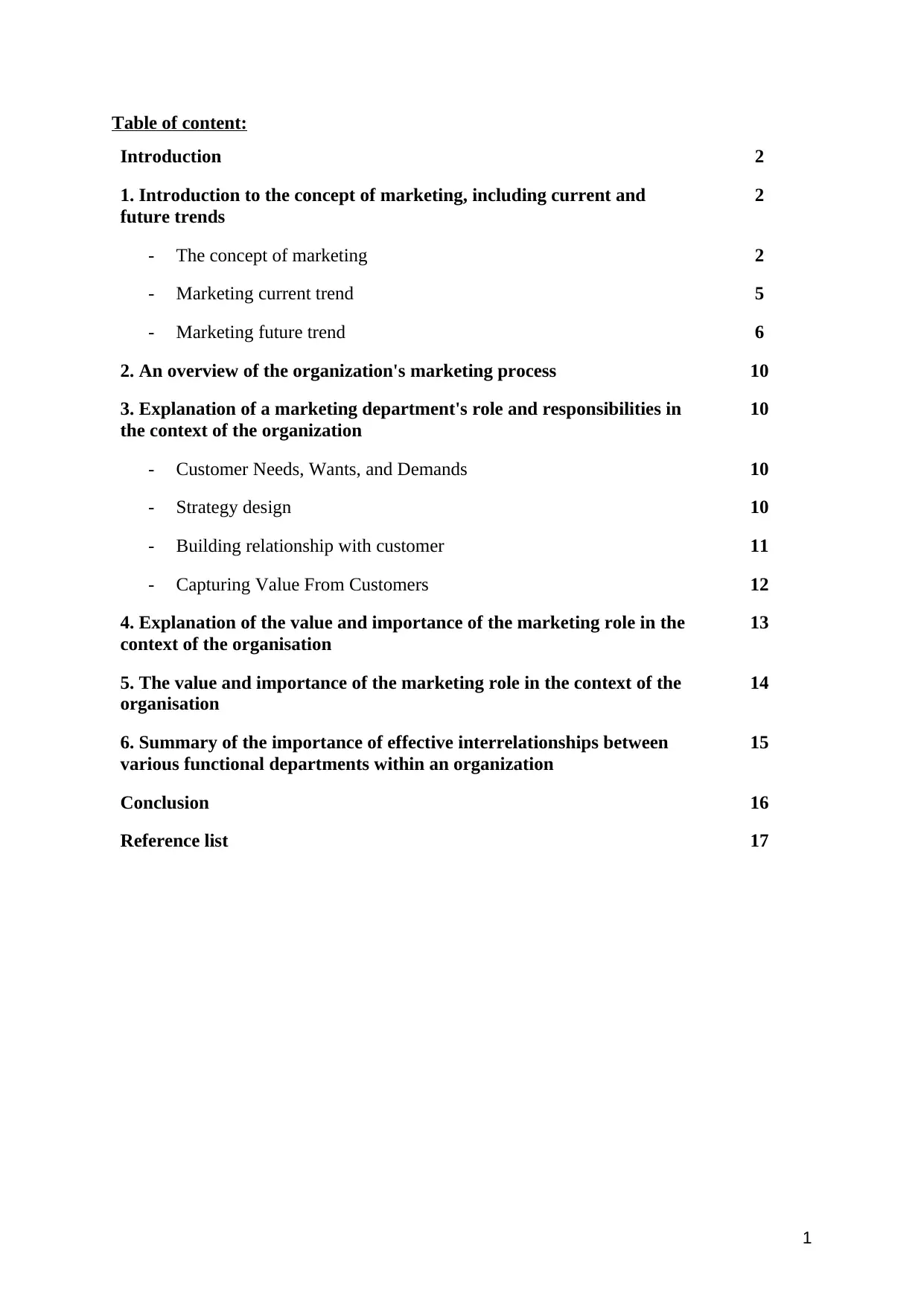
Table of content:
Introduction 2
1. Introduction to the concept of marketing, including current and
future trends
2
- The concept of marketing 2
- Marketing current trend 5
- Marketing future trend 6
2. An overview of the organization's marketing process 10
3. Explanation of a marketing department's role and responsibilities in
the context of the organization
10
- Customer Needs, Wants, and Demands 10
- Strategy design 10
- Building relationship with customer 11
- Capturing Value From Customers 12
4. Explanation of the value and importance of the marketing role in the
context of the organisation
13
5. The value and importance of the marketing role in the context of the
organisation
14
6. Summary of the importance of effective interrelationships between
various functional departments within an organization
15
Conclusion 16
Reference list 17
1
Introduction 2
1. Introduction to the concept of marketing, including current and
future trends
2
- The concept of marketing 2
- Marketing current trend 5
- Marketing future trend 6
2. An overview of the organization's marketing process 10
3. Explanation of a marketing department's role and responsibilities in
the context of the organization
10
- Customer Needs, Wants, and Demands 10
- Strategy design 10
- Building relationship with customer 11
- Capturing Value From Customers 12
4. Explanation of the value and importance of the marketing role in the
context of the organisation
13
5. The value and importance of the marketing role in the context of the
organisation
14
6. Summary of the importance of effective interrelationships between
various functional departments within an organization
15
Conclusion 16
Reference list 17
1
Paraphrase This Document
Need a fresh take? Get an instant paraphrase of this document with our AI Paraphraser
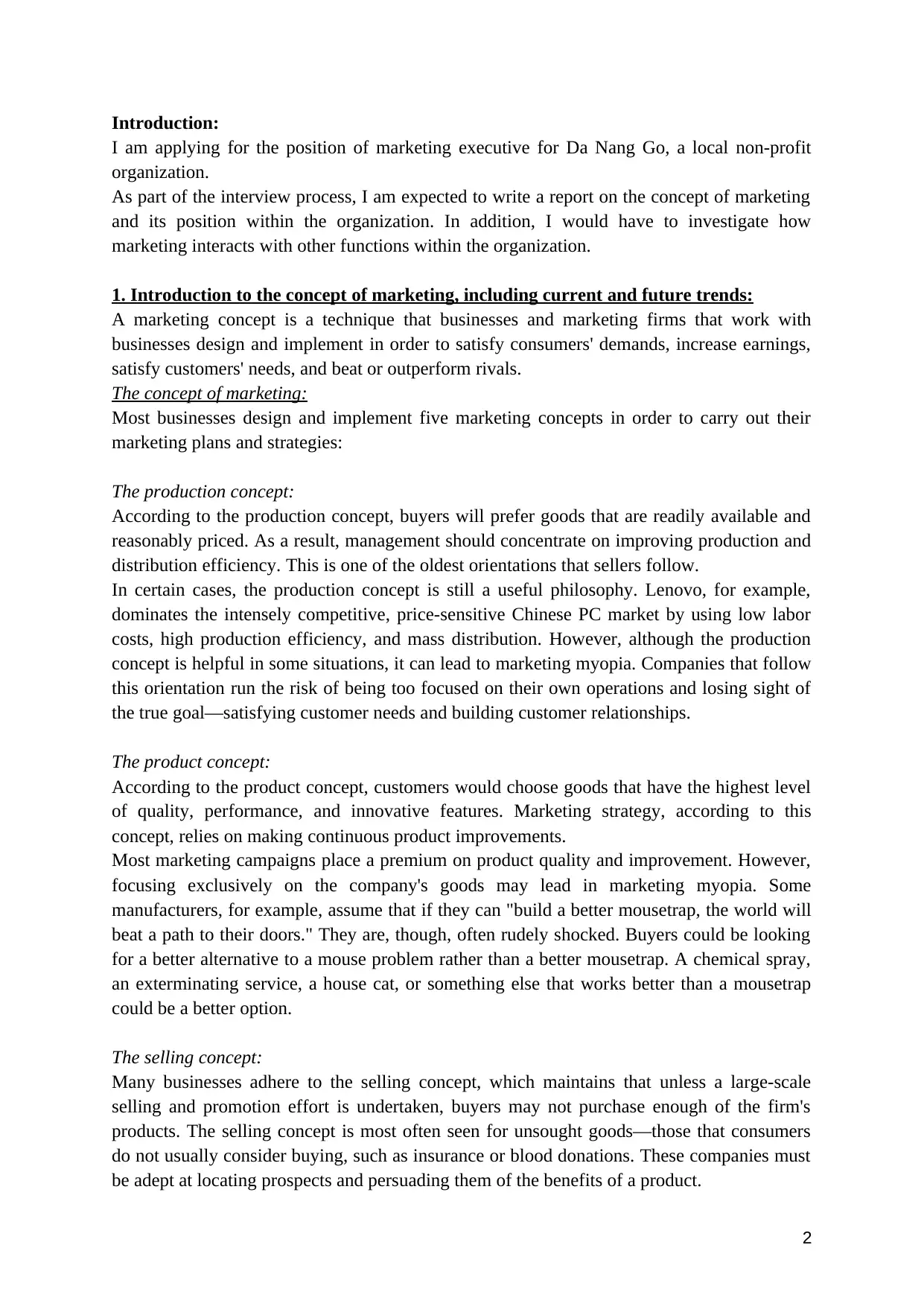
Introduction:
I am applying for the position of marketing executive for Da Nang Go, a local non-profit
organization.
As part of the interview process, I am expected to write a report on the concept of marketing
and its position within the organization. In addition, I would have to investigate how
marketing interacts with other functions within the organization.
1. Introduction to the concept of marketing, including current and future trends:
A marketing concept is a technique that businesses and marketing firms that work with
businesses design and implement in order to satisfy consumers' demands, increase earnings,
satisfy customers' needs, and beat or outperform rivals.
The concept of marketing:
Most businesses design and implement five marketing concepts in order to carry out their
marketing plans and strategies:
The production concept:
According to the production concept, buyers will prefer goods that are readily available and
reasonably priced. As a result, management should concentrate on improving production and
distribution efficiency. This is one of the oldest orientations that sellers follow.
In certain cases, the production concept is still a useful philosophy. Lenovo, for example,
dominates the intensely competitive, price-sensitive Chinese PC market by using low labor
costs, high production efficiency, and mass distribution. However, although the production
concept is helpful in some situations, it can lead to marketing myopia. Companies that follow
this orientation run the risk of being too focused on their own operations and losing sight of
the true goal—satisfying customer needs and building customer relationships.
The product concept:
According to the product concept, customers would choose goods that have the highest level
of quality, performance, and innovative features. Marketing strategy, according to this
concept, relies on making continuous product improvements.
Most marketing campaigns place a premium on product quality and improvement. However,
focusing exclusively on the company's goods may lead in marketing myopia. Some
manufacturers, for example, assume that if they can "build a better mousetrap, the world will
beat a path to their doors." They are, though, often rudely shocked. Buyers could be looking
for a better alternative to a mouse problem rather than a better mousetrap. A chemical spray,
an exterminating service, a house cat, or something else that works better than a mousetrap
could be a better option.
The selling concept:
Many businesses adhere to the selling concept, which maintains that unless a large-scale
selling and promotion effort is undertaken, buyers may not purchase enough of the firm's
products. The selling concept is most often seen for unsought goods—those that consumers
do not usually consider buying, such as insurance or blood donations. These companies must
be adept at locating prospects and persuading them of the benefits of a product.
2
I am applying for the position of marketing executive for Da Nang Go, a local non-profit
organization.
As part of the interview process, I am expected to write a report on the concept of marketing
and its position within the organization. In addition, I would have to investigate how
marketing interacts with other functions within the organization.
1. Introduction to the concept of marketing, including current and future trends:
A marketing concept is a technique that businesses and marketing firms that work with
businesses design and implement in order to satisfy consumers' demands, increase earnings,
satisfy customers' needs, and beat or outperform rivals.
The concept of marketing:
Most businesses design and implement five marketing concepts in order to carry out their
marketing plans and strategies:
The production concept:
According to the production concept, buyers will prefer goods that are readily available and
reasonably priced. As a result, management should concentrate on improving production and
distribution efficiency. This is one of the oldest orientations that sellers follow.
In certain cases, the production concept is still a useful philosophy. Lenovo, for example,
dominates the intensely competitive, price-sensitive Chinese PC market by using low labor
costs, high production efficiency, and mass distribution. However, although the production
concept is helpful in some situations, it can lead to marketing myopia. Companies that follow
this orientation run the risk of being too focused on their own operations and losing sight of
the true goal—satisfying customer needs and building customer relationships.
The product concept:
According to the product concept, customers would choose goods that have the highest level
of quality, performance, and innovative features. Marketing strategy, according to this
concept, relies on making continuous product improvements.
Most marketing campaigns place a premium on product quality and improvement. However,
focusing exclusively on the company's goods may lead in marketing myopia. Some
manufacturers, for example, assume that if they can "build a better mousetrap, the world will
beat a path to their doors." They are, though, often rudely shocked. Buyers could be looking
for a better alternative to a mouse problem rather than a better mousetrap. A chemical spray,
an exterminating service, a house cat, or something else that works better than a mousetrap
could be a better option.
The selling concept:
Many businesses adhere to the selling concept, which maintains that unless a large-scale
selling and promotion effort is undertaken, buyers may not purchase enough of the firm's
products. The selling concept is most often seen for unsought goods—those that consumers
do not usually consider buying, such as insurance or blood donations. These companies must
be adept at locating prospects and persuading them of the benefits of a product.
2
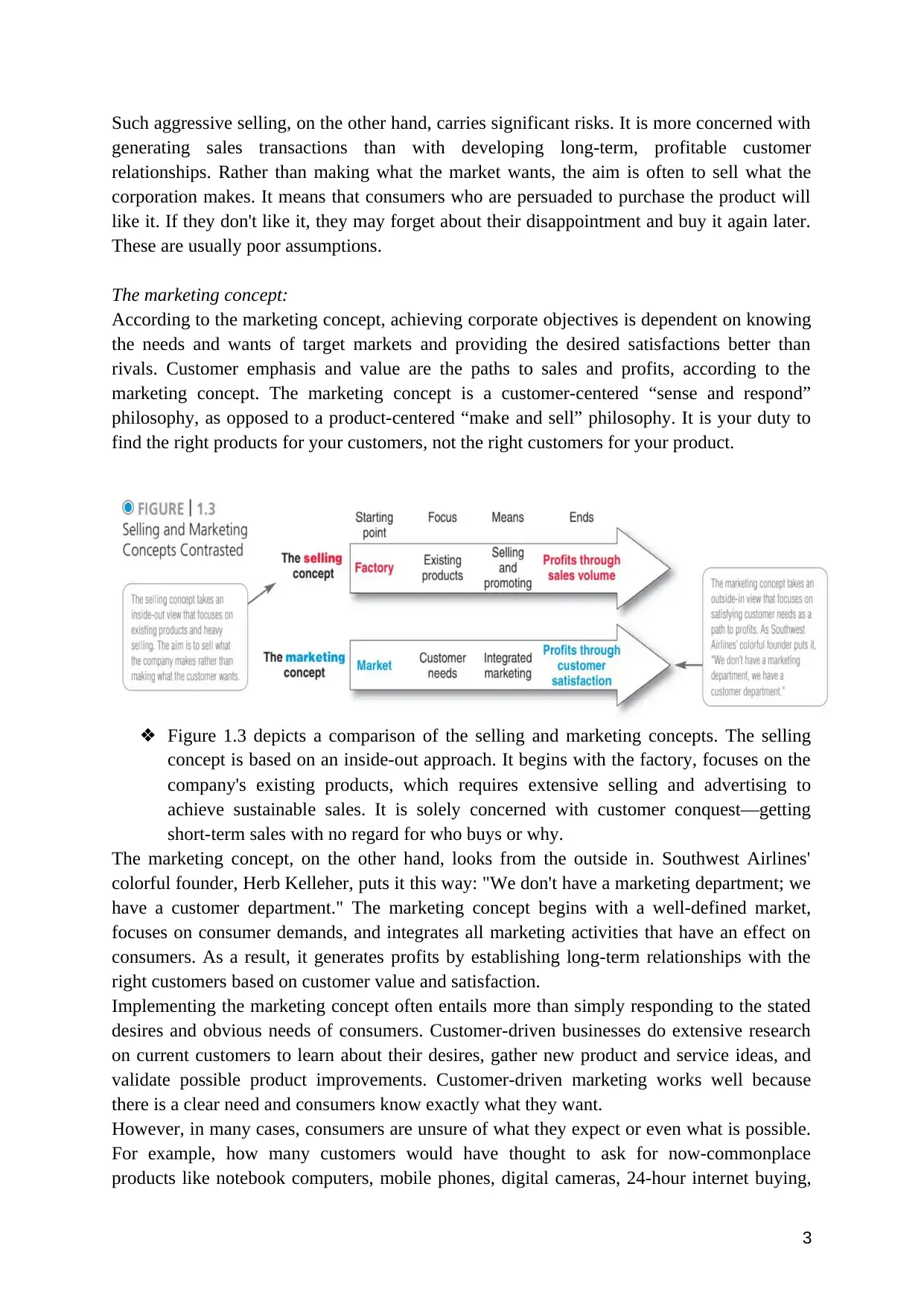
Such aggressive selling, on the other hand, carries significant risks. It is more concerned with
generating sales transactions than with developing long-term, profitable customer
relationships. Rather than making what the market wants, the aim is often to sell what the
corporation makes. It means that consumers who are persuaded to purchase the product will
like it. If they don't like it, they may forget about their disappointment and buy it again later.
These are usually poor assumptions.
The marketing concept:
According to the marketing concept, achieving corporate objectives is dependent on knowing
the needs and wants of target markets and providing the desired satisfactions better than
rivals. Customer emphasis and value are the paths to sales and profits, according to the
marketing concept. The marketing concept is a customer-centered “sense and respond”
philosophy, as opposed to a product-centered “make and sell” philosophy. It is your duty to
find the right products for your customers, not the right customers for your product.
❖ Figure 1.3 depicts a comparison of the selling and marketing concepts. The selling
concept is based on an inside-out approach. It begins with the factory, focuses on the
company's existing products, which requires extensive selling and advertising to
achieve sustainable sales. It is solely concerned with customer conquest—getting
short-term sales with no regard for who buys or why.
The marketing concept, on the other hand, looks from the outside in. Southwest Airlines'
colorful founder, Herb Kelleher, puts it this way: "We don't have a marketing department; we
have a customer department." The marketing concept begins with a well-defined market,
focuses on consumer demands, and integrates all marketing activities that have an effect on
consumers. As a result, it generates profits by establishing long-term relationships with the
right customers based on customer value and satisfaction.
Implementing the marketing concept often entails more than simply responding to the stated
desires and obvious needs of consumers. Customer-driven businesses do extensive research
on current customers to learn about their desires, gather new product and service ideas, and
validate possible product improvements. Customer-driven marketing works well because
there is a clear need and consumers know exactly what they want.
However, in many cases, consumers are unsure of what they expect or even what is possible.
For example, how many customers would have thought to ask for now-commonplace
products like notebook computers, mobile phones, digital cameras, 24-hour internet buying,
3
generating sales transactions than with developing long-term, profitable customer
relationships. Rather than making what the market wants, the aim is often to sell what the
corporation makes. It means that consumers who are persuaded to purchase the product will
like it. If they don't like it, they may forget about their disappointment and buy it again later.
These are usually poor assumptions.
The marketing concept:
According to the marketing concept, achieving corporate objectives is dependent on knowing
the needs and wants of target markets and providing the desired satisfactions better than
rivals. Customer emphasis and value are the paths to sales and profits, according to the
marketing concept. The marketing concept is a customer-centered “sense and respond”
philosophy, as opposed to a product-centered “make and sell” philosophy. It is your duty to
find the right products for your customers, not the right customers for your product.
❖ Figure 1.3 depicts a comparison of the selling and marketing concepts. The selling
concept is based on an inside-out approach. It begins with the factory, focuses on the
company's existing products, which requires extensive selling and advertising to
achieve sustainable sales. It is solely concerned with customer conquest—getting
short-term sales with no regard for who buys or why.
The marketing concept, on the other hand, looks from the outside in. Southwest Airlines'
colorful founder, Herb Kelleher, puts it this way: "We don't have a marketing department; we
have a customer department." The marketing concept begins with a well-defined market,
focuses on consumer demands, and integrates all marketing activities that have an effect on
consumers. As a result, it generates profits by establishing long-term relationships with the
right customers based on customer value and satisfaction.
Implementing the marketing concept often entails more than simply responding to the stated
desires and obvious needs of consumers. Customer-driven businesses do extensive research
on current customers to learn about their desires, gather new product and service ideas, and
validate possible product improvements. Customer-driven marketing works well because
there is a clear need and consumers know exactly what they want.
However, in many cases, consumers are unsure of what they expect or even what is possible.
For example, how many customers would have thought to ask for now-commonplace
products like notebook computers, mobile phones, digital cameras, 24-hour internet buying,
3
⊘ This is a preview!⊘
Do you want full access?
Subscribe today to unlock all pages.

Trusted by 1+ million students worldwide
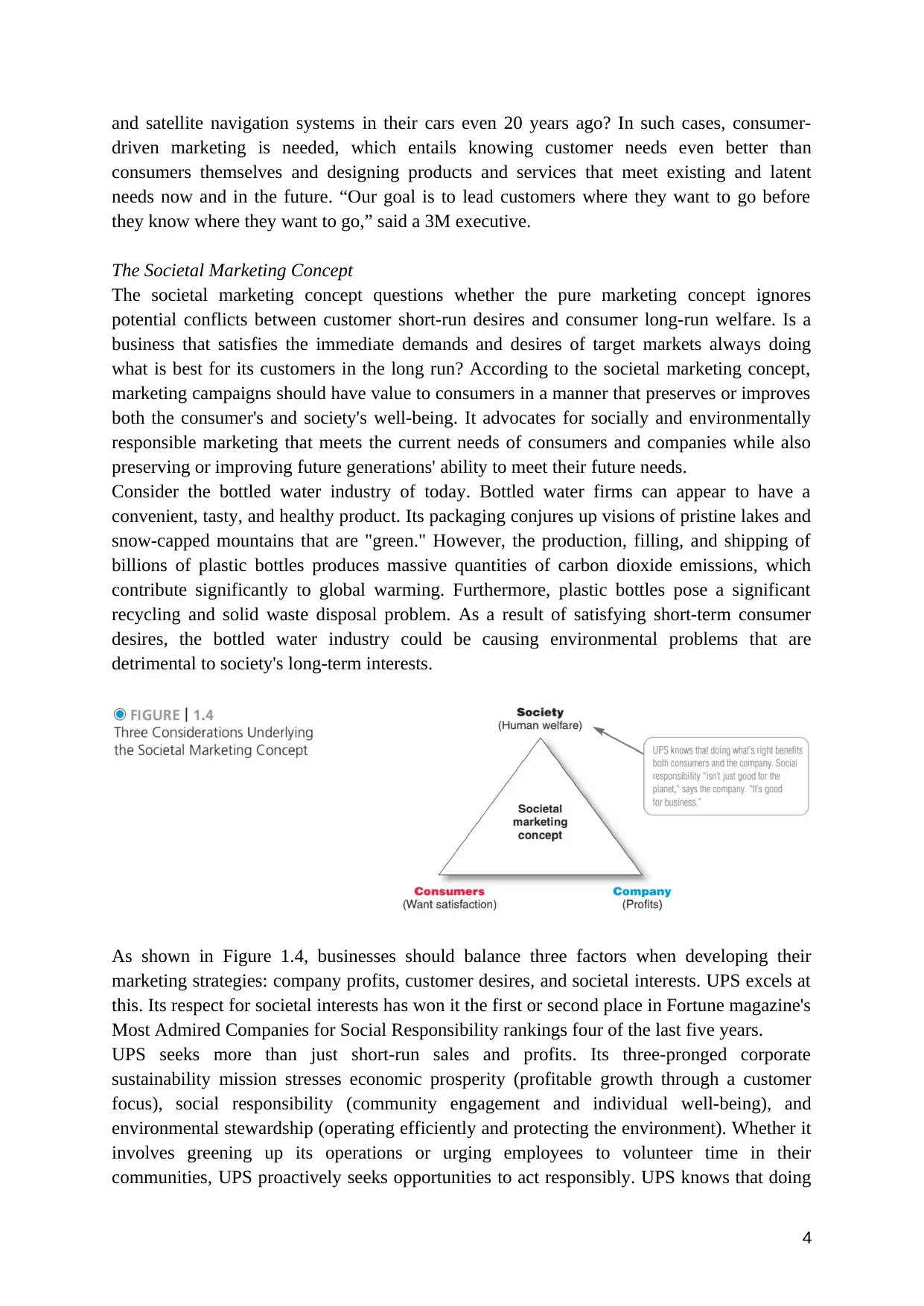
and satellite navigation systems in their cars even 20 years ago? In such cases, consumer-
driven marketing is needed, which entails knowing customer needs even better than
consumers themselves and designing products and services that meet existing and latent
needs now and in the future. “Our goal is to lead customers where they want to go before
they know where they want to go,” said a 3M executive.
The Societal Marketing Concept
The societal marketing concept questions whether the pure marketing concept ignores
potential conflicts between customer short-run desires and consumer long-run welfare. Is a
business that satisfies the immediate demands and desires of target markets always doing
what is best for its customers in the long run? According to the societal marketing concept,
marketing campaigns should have value to consumers in a manner that preserves or improves
both the consumer's and society's well-being. It advocates for socially and environmentally
responsible marketing that meets the current needs of consumers and companies while also
preserving or improving future generations' ability to meet their future needs.
Consider the bottled water industry of today. Bottled water firms can appear to have a
convenient, tasty, and healthy product. Its packaging conjures up visions of pristine lakes and
snow-capped mountains that are "green." However, the production, filling, and shipping of
billions of plastic bottles produces massive quantities of carbon dioxide emissions, which
contribute significantly to global warming. Furthermore, plastic bottles pose a significant
recycling and solid waste disposal problem. As a result of satisfying short-term consumer
desires, the bottled water industry could be causing environmental problems that are
detrimental to society's long-term interests.
As shown in Figure 1.4, businesses should balance three factors when developing their
marketing strategies: company profits, customer desires, and societal interests. UPS excels at
this. Its respect for societal interests has won it the first or second place in Fortune magazine's
Most Admired Companies for Social Responsibility rankings four of the last five years.
UPS seeks more than just short-run sales and profits. Its three-pronged corporate
sustainability mission stresses economic prosperity (profitable growth through a customer
focus), social responsibility (community engagement and individual well-being), and
environmental stewardship (operating efficiently and protecting the environment). Whether it
involves greening up its operations or urging employees to volunteer time in their
communities, UPS proactively seeks opportunities to act responsibly. UPS knows that doing
4
driven marketing is needed, which entails knowing customer needs even better than
consumers themselves and designing products and services that meet existing and latent
needs now and in the future. “Our goal is to lead customers where they want to go before
they know where they want to go,” said a 3M executive.
The Societal Marketing Concept
The societal marketing concept questions whether the pure marketing concept ignores
potential conflicts between customer short-run desires and consumer long-run welfare. Is a
business that satisfies the immediate demands and desires of target markets always doing
what is best for its customers in the long run? According to the societal marketing concept,
marketing campaigns should have value to consumers in a manner that preserves or improves
both the consumer's and society's well-being. It advocates for socially and environmentally
responsible marketing that meets the current needs of consumers and companies while also
preserving or improving future generations' ability to meet their future needs.
Consider the bottled water industry of today. Bottled water firms can appear to have a
convenient, tasty, and healthy product. Its packaging conjures up visions of pristine lakes and
snow-capped mountains that are "green." However, the production, filling, and shipping of
billions of plastic bottles produces massive quantities of carbon dioxide emissions, which
contribute significantly to global warming. Furthermore, plastic bottles pose a significant
recycling and solid waste disposal problem. As a result of satisfying short-term consumer
desires, the bottled water industry could be causing environmental problems that are
detrimental to society's long-term interests.
As shown in Figure 1.4, businesses should balance three factors when developing their
marketing strategies: company profits, customer desires, and societal interests. UPS excels at
this. Its respect for societal interests has won it the first or second place in Fortune magazine's
Most Admired Companies for Social Responsibility rankings four of the last five years.
UPS seeks more than just short-run sales and profits. Its three-pronged corporate
sustainability mission stresses economic prosperity (profitable growth through a customer
focus), social responsibility (community engagement and individual well-being), and
environmental stewardship (operating efficiently and protecting the environment). Whether it
involves greening up its operations or urging employees to volunteer time in their
communities, UPS proactively seeks opportunities to act responsibly. UPS knows that doing
4
Paraphrase This Document
Need a fresh take? Get an instant paraphrase of this document with our AI Paraphraser
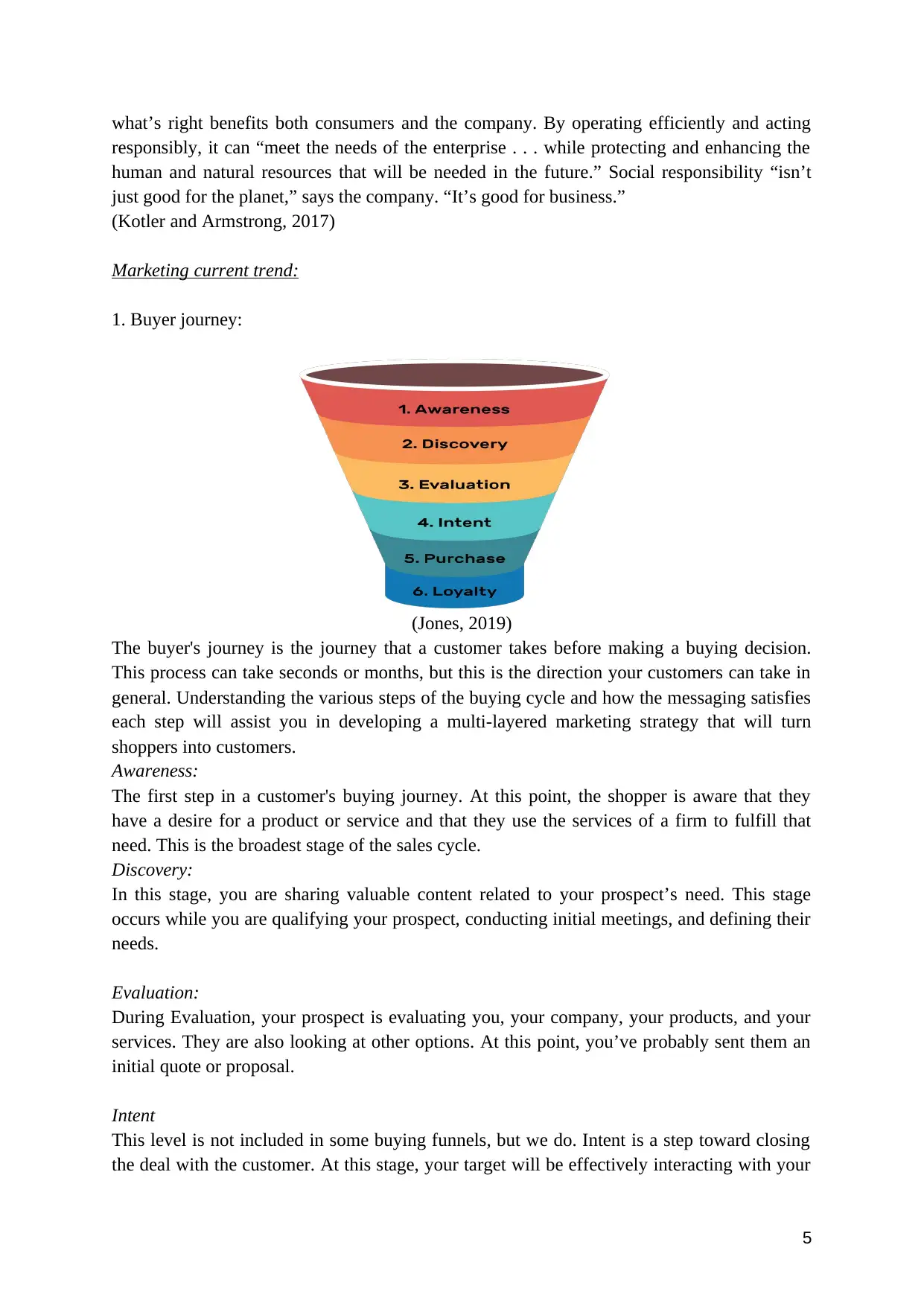
what’s right benefits both consumers and the company. By operating efficiently and acting
responsibly, it can “meet the needs of the enterprise . . . while protecting and enhancing the
human and natural resources that will be needed in the future.” Social responsibility “isn’t
just good for the planet,” says the company. “It’s good for business.”
(Kotler and Armstrong, 2017)
Marketing current trend:
1. Buyer journey:
(Jones, 2019)
The buyer's journey is the journey that a customer takes before making a buying decision.
This process can take seconds or months, but this is the direction your customers can take in
general. Understanding the various steps of the buying cycle and how the messaging satisfies
each step will assist you in developing a multi-layered marketing strategy that will turn
shoppers into customers.
Awareness:
The first step in a customer's buying journey. At this point, the shopper is aware that they
have a desire for a product or service and that they use the services of a firm to fulfill that
need. This is the broadest stage of the sales cycle.
Discovery:
In this stage, you are sharing valuable content related to your prospect’s need. This stage
occurs while you are qualifying your prospect, conducting initial meetings, and defining their
needs.
Evaluation:
During Evaluation, your prospect is evaluating you, your company, your products, and your
services. They are also looking at other options. At this point, you’ve probably sent them an
initial quote or proposal.
Intent
This level is not included in some buying funnels, but we do. Intent is a step toward closing
the deal with the customer. At this stage, your target will be effectively interacting with your
5
responsibly, it can “meet the needs of the enterprise . . . while protecting and enhancing the
human and natural resources that will be needed in the future.” Social responsibility “isn’t
just good for the planet,” says the company. “It’s good for business.”
(Kotler and Armstrong, 2017)
Marketing current trend:
1. Buyer journey:
(Jones, 2019)
The buyer's journey is the journey that a customer takes before making a buying decision.
This process can take seconds or months, but this is the direction your customers can take in
general. Understanding the various steps of the buying cycle and how the messaging satisfies
each step will assist you in developing a multi-layered marketing strategy that will turn
shoppers into customers.
Awareness:
The first step in a customer's buying journey. At this point, the shopper is aware that they
have a desire for a product or service and that they use the services of a firm to fulfill that
need. This is the broadest stage of the sales cycle.
Discovery:
In this stage, you are sharing valuable content related to your prospect’s need. This stage
occurs while you are qualifying your prospect, conducting initial meetings, and defining their
needs.
Evaluation:
During Evaluation, your prospect is evaluating you, your company, your products, and your
services. They are also looking at other options. At this point, you’ve probably sent them an
initial quote or proposal.
Intent
This level is not included in some buying funnels, but we do. Intent is a step toward closing
the deal with the customer. At this stage, your target will be effectively interacting with your
5
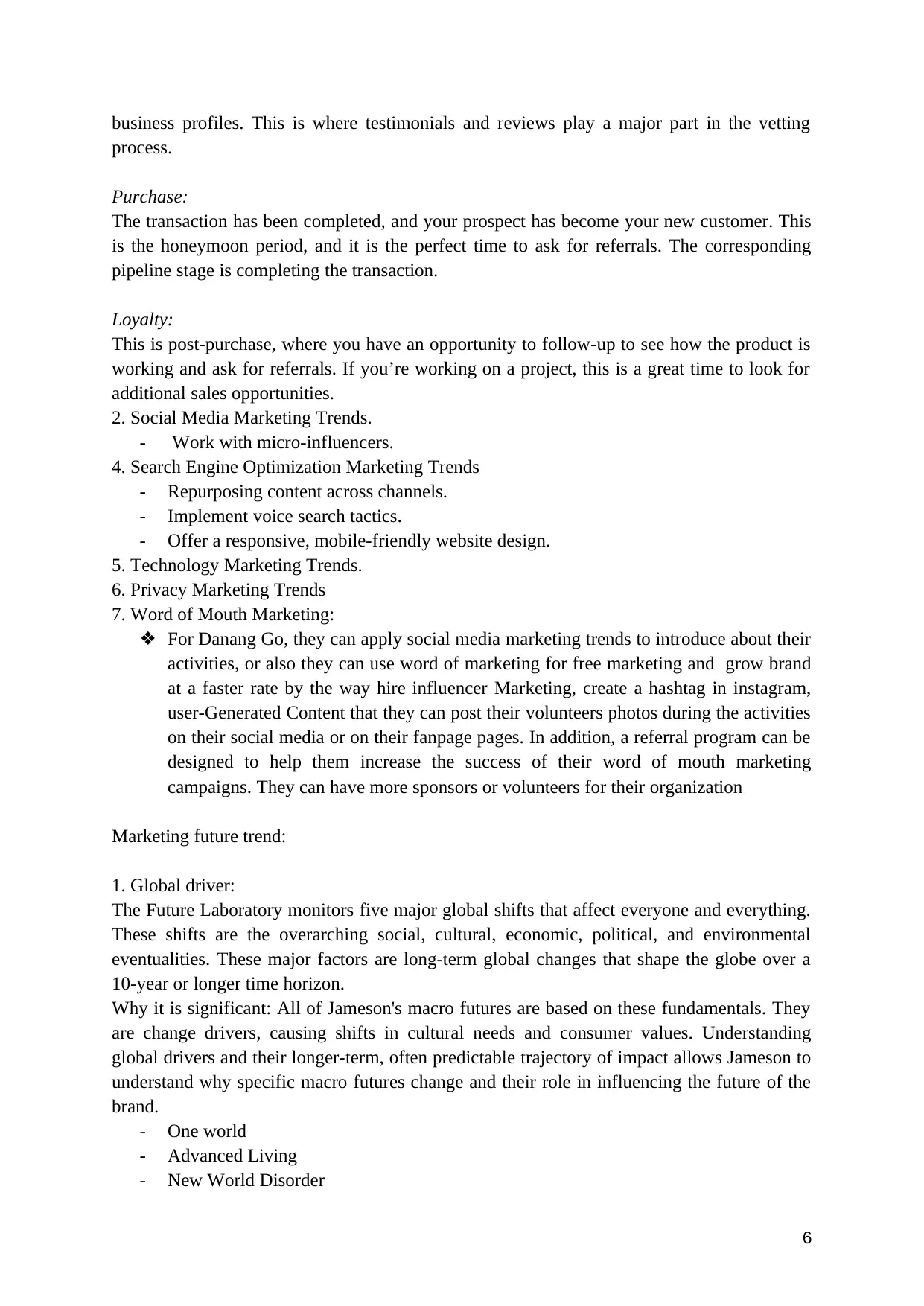
business profiles. This is where testimonials and reviews play a major part in the vetting
process.
Purchase:
The transaction has been completed, and your prospect has become your new customer. This
is the honeymoon period, and it is the perfect time to ask for referrals. The corresponding
pipeline stage is completing the transaction.
Loyalty:
This is post-purchase, where you have an opportunity to follow-up to see how the product is
working and ask for referrals. If you’re working on a project, this is a great time to look for
additional sales opportunities.
2. Social Media Marketing Trends.
- Work with micro-influencers.
4. Search Engine Optimization Marketing Trends
- Repurposing content across channels.
- Implement voice search tactics.
- Offer a responsive, mobile-friendly website design.
5. Technology Marketing Trends.
6. Privacy Marketing Trends
7. Word of Mouth Marketing:
❖ For Danang Go, they can apply social media marketing trends to introduce about their
activities, or also they can use word of marketing for free marketing and grow brand
at a faster rate by the way hire influencer Marketing, create a hashtag in instagram,
user-Generated Content that they can post their volunteers photos during the activities
on their social media or on their fanpage pages. In addition, a referral program can be
designed to help them increase the success of their word of mouth marketing
campaigns. They can have more sponsors or volunteers for their organization
Marketing future trend:
1. Global driver:
The Future Laboratory monitors five major global shifts that affect everyone and everything.
These shifts are the overarching social, cultural, economic, political, and environmental
eventualities. These major factors are long-term global changes that shape the globe over a
10-year or longer time horizon.
Why it is significant: All of Jameson's macro futures are based on these fundamentals. They
are change drivers, causing shifts in cultural needs and consumer values. Understanding
global drivers and their longer-term, often predictable trajectory of impact allows Jameson to
understand why specific macro futures change and their role in influencing the future of the
brand.
- One world
- Advanced Living
- New World Disorder
6
process.
Purchase:
The transaction has been completed, and your prospect has become your new customer. This
is the honeymoon period, and it is the perfect time to ask for referrals. The corresponding
pipeline stage is completing the transaction.
Loyalty:
This is post-purchase, where you have an opportunity to follow-up to see how the product is
working and ask for referrals. If you’re working on a project, this is a great time to look for
additional sales opportunities.
2. Social Media Marketing Trends.
- Work with micro-influencers.
4. Search Engine Optimization Marketing Trends
- Repurposing content across channels.
- Implement voice search tactics.
- Offer a responsive, mobile-friendly website design.
5. Technology Marketing Trends.
6. Privacy Marketing Trends
7. Word of Mouth Marketing:
❖ For Danang Go, they can apply social media marketing trends to introduce about their
activities, or also they can use word of marketing for free marketing and grow brand
at a faster rate by the way hire influencer Marketing, create a hashtag in instagram,
user-Generated Content that they can post their volunteers photos during the activities
on their social media or on their fanpage pages. In addition, a referral program can be
designed to help them increase the success of their word of mouth marketing
campaigns. They can have more sponsors or volunteers for their organization
Marketing future trend:
1. Global driver:
The Future Laboratory monitors five major global shifts that affect everyone and everything.
These shifts are the overarching social, cultural, economic, political, and environmental
eventualities. These major factors are long-term global changes that shape the globe over a
10-year or longer time horizon.
Why it is significant: All of Jameson's macro futures are based on these fundamentals. They
are change drivers, causing shifts in cultural needs and consumer values. Understanding
global drivers and their longer-term, often predictable trajectory of impact allows Jameson to
understand why specific macro futures change and their role in influencing the future of the
brand.
- One world
- Advanced Living
- New World Disorder
6
⊘ This is a preview!⊘
Do you want full access?
Subscribe today to unlock all pages.

Trusted by 1+ million students worldwide
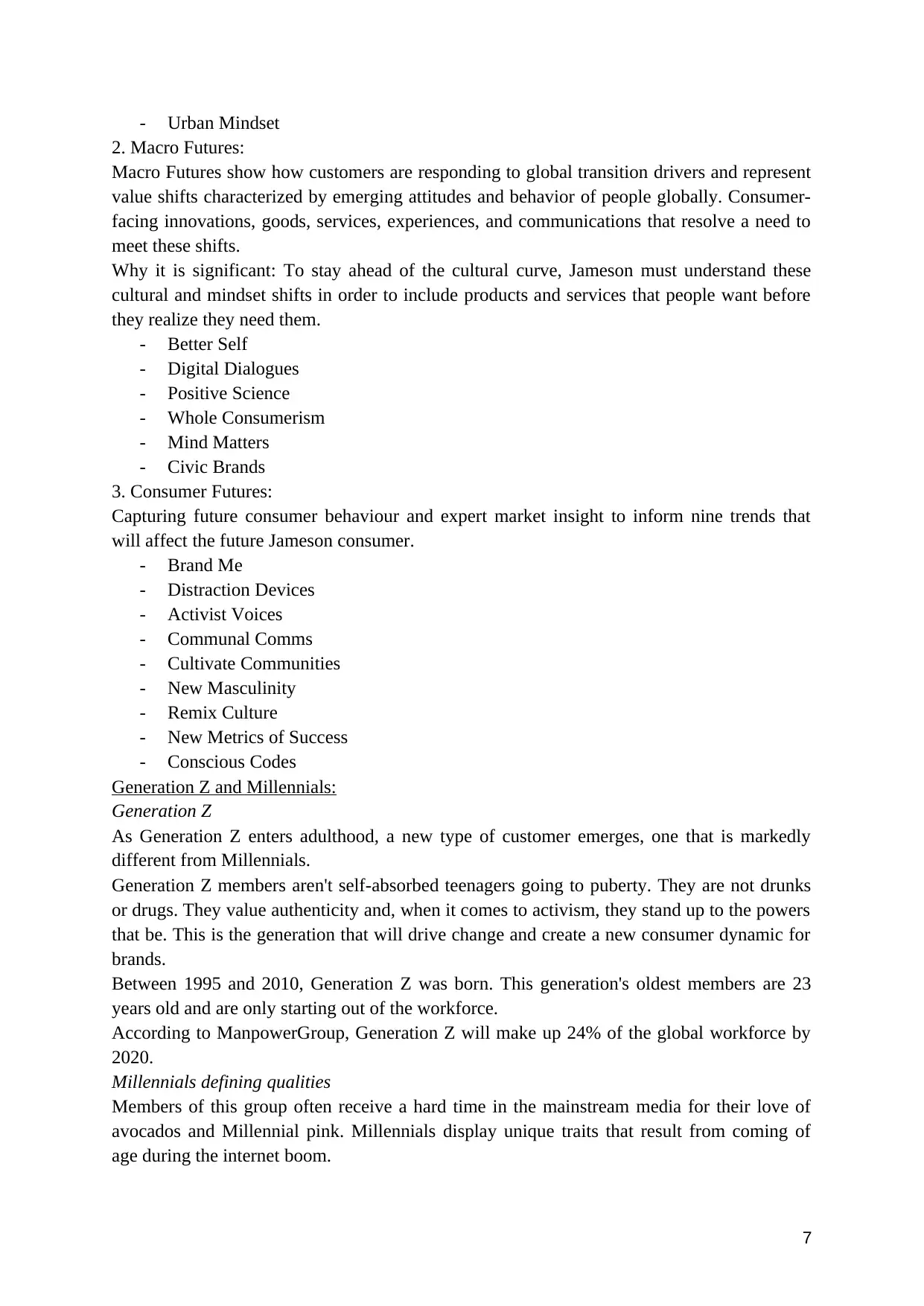
- Urban Mindset
2. Macro Futures:
Macro Futures show how customers are responding to global transition drivers and represent
value shifts characterized by emerging attitudes and behavior of people globally. Consumer-
facing innovations, goods, services, experiences, and communications that resolve a need to
meet these shifts.
Why it is significant: To stay ahead of the cultural curve, Jameson must understand these
cultural and mindset shifts in order to include products and services that people want before
they realize they need them.
- Better Self
- Digital Dialogues
- Positive Science
- Whole Consumerism
- Mind Matters
- Civic Brands
3. Consumer Futures:
Capturing future consumer behaviour and expert market insight to inform nine trends that
will affect the future Jameson consumer.
- Brand Me
- Distraction Devices
- Activist Voices
- Communal Comms
- Cultivate Communities
- New Masculinity
- Remix Culture
- New Metrics of Success
- Conscious Codes
Generation Z and Millennials:
Generation Z
As Generation Z enters adulthood, a new type of customer emerges, one that is markedly
different from Millennials.
Generation Z members aren't self-absorbed teenagers going to puberty. They are not drunks
or drugs. They value authenticity and, when it comes to activism, they stand up to the powers
that be. This is the generation that will drive change and create a new consumer dynamic for
brands.
Between 1995 and 2010, Generation Z was born. This generation's oldest members are 23
years old and are only starting out of the workforce.
According to ManpowerGroup, Generation Z will make up 24% of the global workforce by
2020.
Millennials defining qualities
Members of this group often receive a hard time in the mainstream media for their love of
avocados and Millennial pink. Millennials display unique traits that result from coming of
age during the internet boom.
7
2. Macro Futures:
Macro Futures show how customers are responding to global transition drivers and represent
value shifts characterized by emerging attitudes and behavior of people globally. Consumer-
facing innovations, goods, services, experiences, and communications that resolve a need to
meet these shifts.
Why it is significant: To stay ahead of the cultural curve, Jameson must understand these
cultural and mindset shifts in order to include products and services that people want before
they realize they need them.
- Better Self
- Digital Dialogues
- Positive Science
- Whole Consumerism
- Mind Matters
- Civic Brands
3. Consumer Futures:
Capturing future consumer behaviour and expert market insight to inform nine trends that
will affect the future Jameson consumer.
- Brand Me
- Distraction Devices
- Activist Voices
- Communal Comms
- Cultivate Communities
- New Masculinity
- Remix Culture
- New Metrics of Success
- Conscious Codes
Generation Z and Millennials:
Generation Z
As Generation Z enters adulthood, a new type of customer emerges, one that is markedly
different from Millennials.
Generation Z members aren't self-absorbed teenagers going to puberty. They are not drunks
or drugs. They value authenticity and, when it comes to activism, they stand up to the powers
that be. This is the generation that will drive change and create a new consumer dynamic for
brands.
Between 1995 and 2010, Generation Z was born. This generation's oldest members are 23
years old and are only starting out of the workforce.
According to ManpowerGroup, Generation Z will make up 24% of the global workforce by
2020.
Millennials defining qualities
Members of this group often receive a hard time in the mainstream media for their love of
avocados and Millennial pink. Millennials display unique traits that result from coming of
age during the internet boom.
7
Paraphrase This Document
Need a fresh take? Get an instant paraphrase of this document with our AI Paraphraser
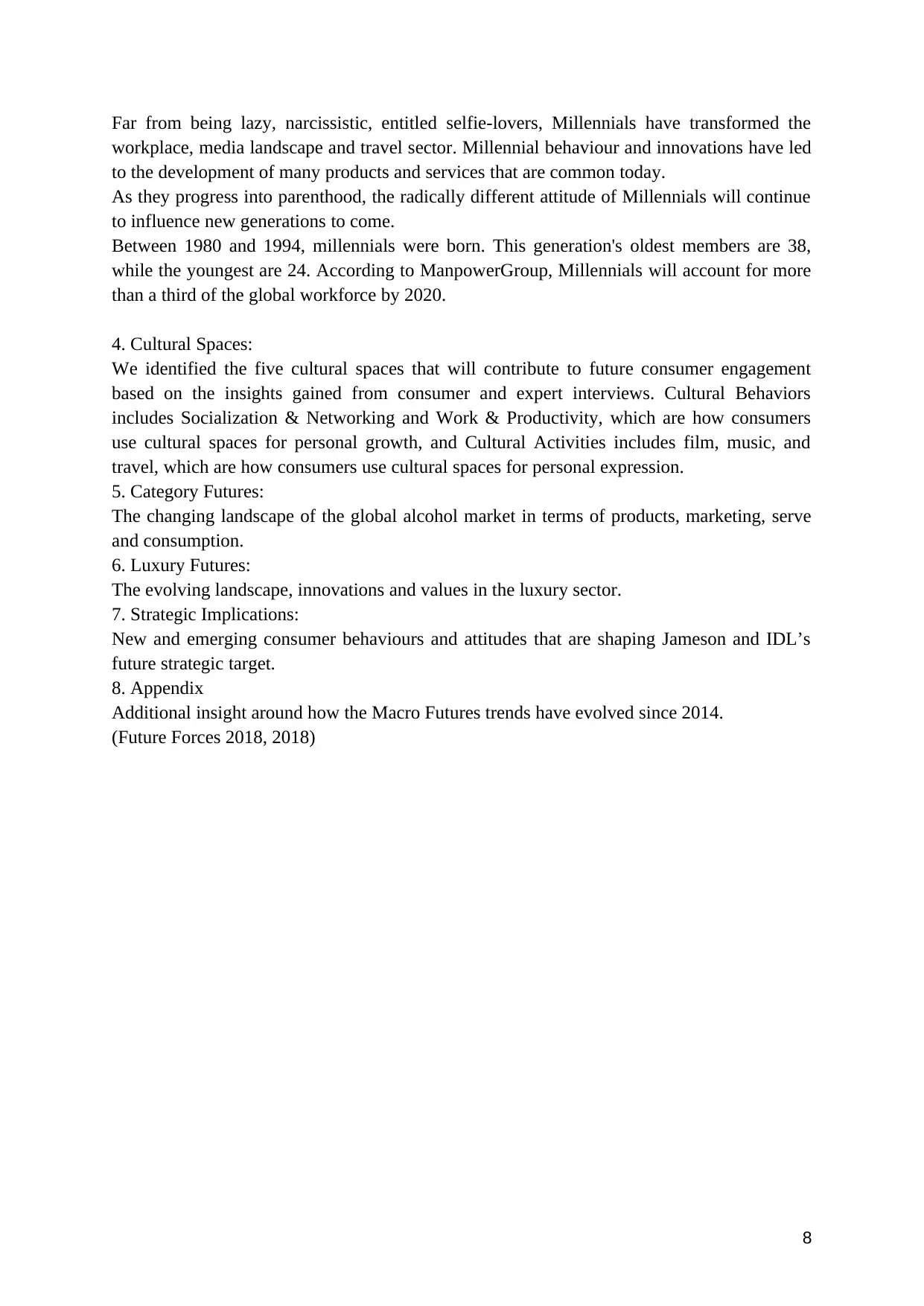
Far from being lazy, narcissistic, entitled selfie-lovers, Millennials have transformed the
workplace, media landscape and travel sector. Millennial behaviour and innovations have led
to the development of many products and services that are common today.
As they progress into parenthood, the radically different attitude of Millennials will continue
to influence new generations to come.
Between 1980 and 1994, millennials were born. This generation's oldest members are 38,
while the youngest are 24. According to ManpowerGroup, Millennials will account for more
than a third of the global workforce by 2020.
4. Cultural Spaces:
We identified the five cultural spaces that will contribute to future consumer engagement
based on the insights gained from consumer and expert interviews. Cultural Behaviors
includes Socialization & Networking and Work & Productivity, which are how consumers
use cultural spaces for personal growth, and Cultural Activities includes film, music, and
travel, which are how consumers use cultural spaces for personal expression.
5. Category Futures:
The changing landscape of the global alcohol market in terms of products, marketing, serve
and consumption.
6. Luxury Futures:
The evolving landscape, innovations and values in the luxury sector.
7. Strategic Implications:
New and emerging consumer behaviours and attitudes that are shaping Jameson and IDL’s
future strategic target.
8. Appendix
Additional insight around how the Macro Futures trends have evolved since 2014.
(Future Forces 2018, 2018)
8
workplace, media landscape and travel sector. Millennial behaviour and innovations have led
to the development of many products and services that are common today.
As they progress into parenthood, the radically different attitude of Millennials will continue
to influence new generations to come.
Between 1980 and 1994, millennials were born. This generation's oldest members are 38,
while the youngest are 24. According to ManpowerGroup, Millennials will account for more
than a third of the global workforce by 2020.
4. Cultural Spaces:
We identified the five cultural spaces that will contribute to future consumer engagement
based on the insights gained from consumer and expert interviews. Cultural Behaviors
includes Socialization & Networking and Work & Productivity, which are how consumers
use cultural spaces for personal growth, and Cultural Activities includes film, music, and
travel, which are how consumers use cultural spaces for personal expression.
5. Category Futures:
The changing landscape of the global alcohol market in terms of products, marketing, serve
and consumption.
6. Luxury Futures:
The evolving landscape, innovations and values in the luxury sector.
7. Strategic Implications:
New and emerging consumer behaviours and attitudes that are shaping Jameson and IDL’s
future strategic target.
8. Appendix
Additional insight around how the Macro Futures trends have evolved since 2014.
(Future Forces 2018, 2018)
8
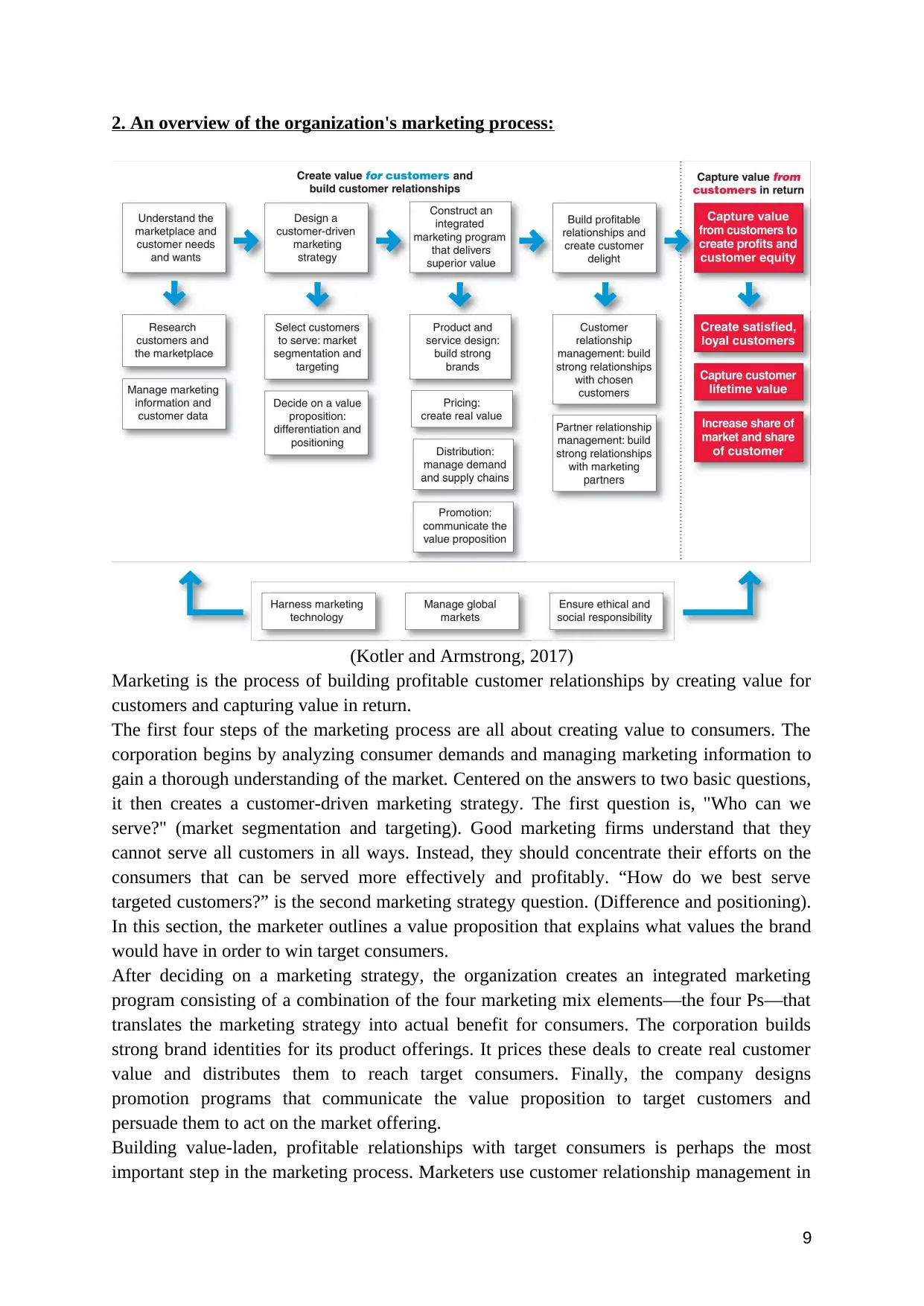
2. An overview of the organization's marketing process:
(Kotler and Armstrong, 2017)
Marketing is the process of building profitable customer relationships by creating value for
customers and capturing value in return.
The first four steps of the marketing process are all about creating value to consumers. The
corporation begins by analyzing consumer demands and managing marketing information to
gain a thorough understanding of the market. Centered on the answers to two basic questions,
it then creates a customer-driven marketing strategy. The first question is, "Who can we
serve?" (market segmentation and targeting). Good marketing firms understand that they
cannot serve all customers in all ways. Instead, they should concentrate their efforts on the
consumers that can be served more effectively and profitably. “How do we best serve
targeted customers?” is the second marketing strategy question. (Difference and positioning).
In this section, the marketer outlines a value proposition that explains what values the brand
would have in order to win target consumers.
After deciding on a marketing strategy, the organization creates an integrated marketing
program consisting of a combination of the four marketing mix elements—the four Ps—that
translates the marketing strategy into actual benefit for consumers. The corporation builds
strong brand identities for its product offerings. It prices these deals to create real customer
value and distributes them to reach target consumers. Finally, the company designs
promotion programs that communicate the value proposition to target customers and
persuade them to act on the market offering.
Building value-laden, profitable relationships with target consumers is perhaps the most
important step in the marketing process. Marketers use customer relationship management in
9
(Kotler and Armstrong, 2017)
Marketing is the process of building profitable customer relationships by creating value for
customers and capturing value in return.
The first four steps of the marketing process are all about creating value to consumers. The
corporation begins by analyzing consumer demands and managing marketing information to
gain a thorough understanding of the market. Centered on the answers to two basic questions,
it then creates a customer-driven marketing strategy. The first question is, "Who can we
serve?" (market segmentation and targeting). Good marketing firms understand that they
cannot serve all customers in all ways. Instead, they should concentrate their efforts on the
consumers that can be served more effectively and profitably. “How do we best serve
targeted customers?” is the second marketing strategy question. (Difference and positioning).
In this section, the marketer outlines a value proposition that explains what values the brand
would have in order to win target consumers.
After deciding on a marketing strategy, the organization creates an integrated marketing
program consisting of a combination of the four marketing mix elements—the four Ps—that
translates the marketing strategy into actual benefit for consumers. The corporation builds
strong brand identities for its product offerings. It prices these deals to create real customer
value and distributes them to reach target consumers. Finally, the company designs
promotion programs that communicate the value proposition to target customers and
persuade them to act on the market offering.
Building value-laden, profitable relationships with target consumers is perhaps the most
important step in the marketing process. Marketers use customer relationship management in
9
⊘ This is a preview!⊘
Do you want full access?
Subscribe today to unlock all pages.

Trusted by 1+ million students worldwide
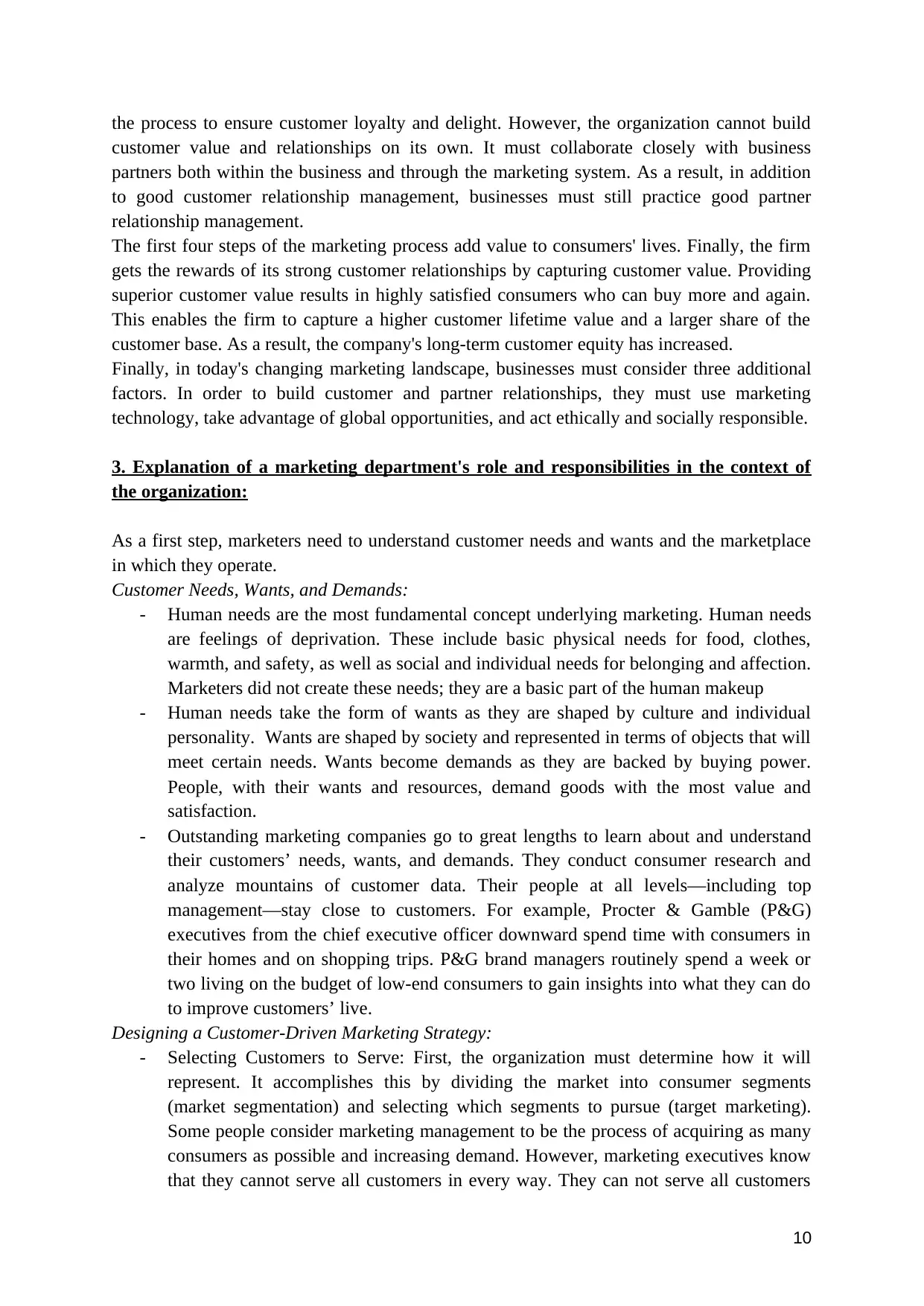
the process to ensure customer loyalty and delight. However, the organization cannot build
customer value and relationships on its own. It must collaborate closely with business
partners both within the business and through the marketing system. As a result, in addition
to good customer relationship management, businesses must still practice good partner
relationship management.
The first four steps of the marketing process add value to consumers' lives. Finally, the firm
gets the rewards of its strong customer relationships by capturing customer value. Providing
superior customer value results in highly satisfied consumers who can buy more and again.
This enables the firm to capture a higher customer lifetime value and a larger share of the
customer base. As a result, the company's long-term customer equity has increased.
Finally, in today's changing marketing landscape, businesses must consider three additional
factors. In order to build customer and partner relationships, they must use marketing
technology, take advantage of global opportunities, and act ethically and socially responsible.
3. Explanation of a marketing department's role and responsibilities in the context of
the organization:
As a first step, marketers need to understand customer needs and wants and the marketplace
in which they operate.
Customer Needs, Wants, and Demands:
- Human needs are the most fundamental concept underlying marketing. Human needs
are feelings of deprivation. These include basic physical needs for food, clothes,
warmth, and safety, as well as social and individual needs for belonging and affection.
Marketers did not create these needs; they are a basic part of the human makeup
- Human needs take the form of wants as they are shaped by culture and individual
personality. Wants are shaped by society and represented in terms of objects that will
meet certain needs. Wants become demands as they are backed by buying power.
People, with their wants and resources, demand goods with the most value and
satisfaction.
- Outstanding marketing companies go to great lengths to learn about and understand
their customers’ needs, wants, and demands. They conduct consumer research and
analyze mountains of customer data. Their people at all levels—including top
management—stay close to customers. For example, Procter & Gamble (P&G)
executives from the chief executive officer downward spend time with consumers in
their homes and on shopping trips. P&G brand managers routinely spend a week or
two living on the budget of low-end consumers to gain insights into what they can do
to improve customers’ live.
Designing a Customer-Driven Marketing Strategy:
- Selecting Customers to Serve: First, the organization must determine how it will
represent. It accomplishes this by dividing the market into consumer segments
(market segmentation) and selecting which segments to pursue (target marketing).
Some people consider marketing management to be the process of acquiring as many
consumers as possible and increasing demand. However, marketing executives know
that they cannot serve all customers in every way. They can not serve all customers
10
customer value and relationships on its own. It must collaborate closely with business
partners both within the business and through the marketing system. As a result, in addition
to good customer relationship management, businesses must still practice good partner
relationship management.
The first four steps of the marketing process add value to consumers' lives. Finally, the firm
gets the rewards of its strong customer relationships by capturing customer value. Providing
superior customer value results in highly satisfied consumers who can buy more and again.
This enables the firm to capture a higher customer lifetime value and a larger share of the
customer base. As a result, the company's long-term customer equity has increased.
Finally, in today's changing marketing landscape, businesses must consider three additional
factors. In order to build customer and partner relationships, they must use marketing
technology, take advantage of global opportunities, and act ethically and socially responsible.
3. Explanation of a marketing department's role and responsibilities in the context of
the organization:
As a first step, marketers need to understand customer needs and wants and the marketplace
in which they operate.
Customer Needs, Wants, and Demands:
- Human needs are the most fundamental concept underlying marketing. Human needs
are feelings of deprivation. These include basic physical needs for food, clothes,
warmth, and safety, as well as social and individual needs for belonging and affection.
Marketers did not create these needs; they are a basic part of the human makeup
- Human needs take the form of wants as they are shaped by culture and individual
personality. Wants are shaped by society and represented in terms of objects that will
meet certain needs. Wants become demands as they are backed by buying power.
People, with their wants and resources, demand goods with the most value and
satisfaction.
- Outstanding marketing companies go to great lengths to learn about and understand
their customers’ needs, wants, and demands. They conduct consumer research and
analyze mountains of customer data. Their people at all levels—including top
management—stay close to customers. For example, Procter & Gamble (P&G)
executives from the chief executive officer downward spend time with consumers in
their homes and on shopping trips. P&G brand managers routinely spend a week or
two living on the budget of low-end consumers to gain insights into what they can do
to improve customers’ live.
Designing a Customer-Driven Marketing Strategy:
- Selecting Customers to Serve: First, the organization must determine how it will
represent. It accomplishes this by dividing the market into consumer segments
(market segmentation) and selecting which segments to pursue (target marketing).
Some people consider marketing management to be the process of acquiring as many
consumers as possible and increasing demand. However, marketing executives know
that they cannot serve all customers in every way. They can not serve all customers
10
Paraphrase This Document
Need a fresh take? Get an instant paraphrase of this document with our AI Paraphraser
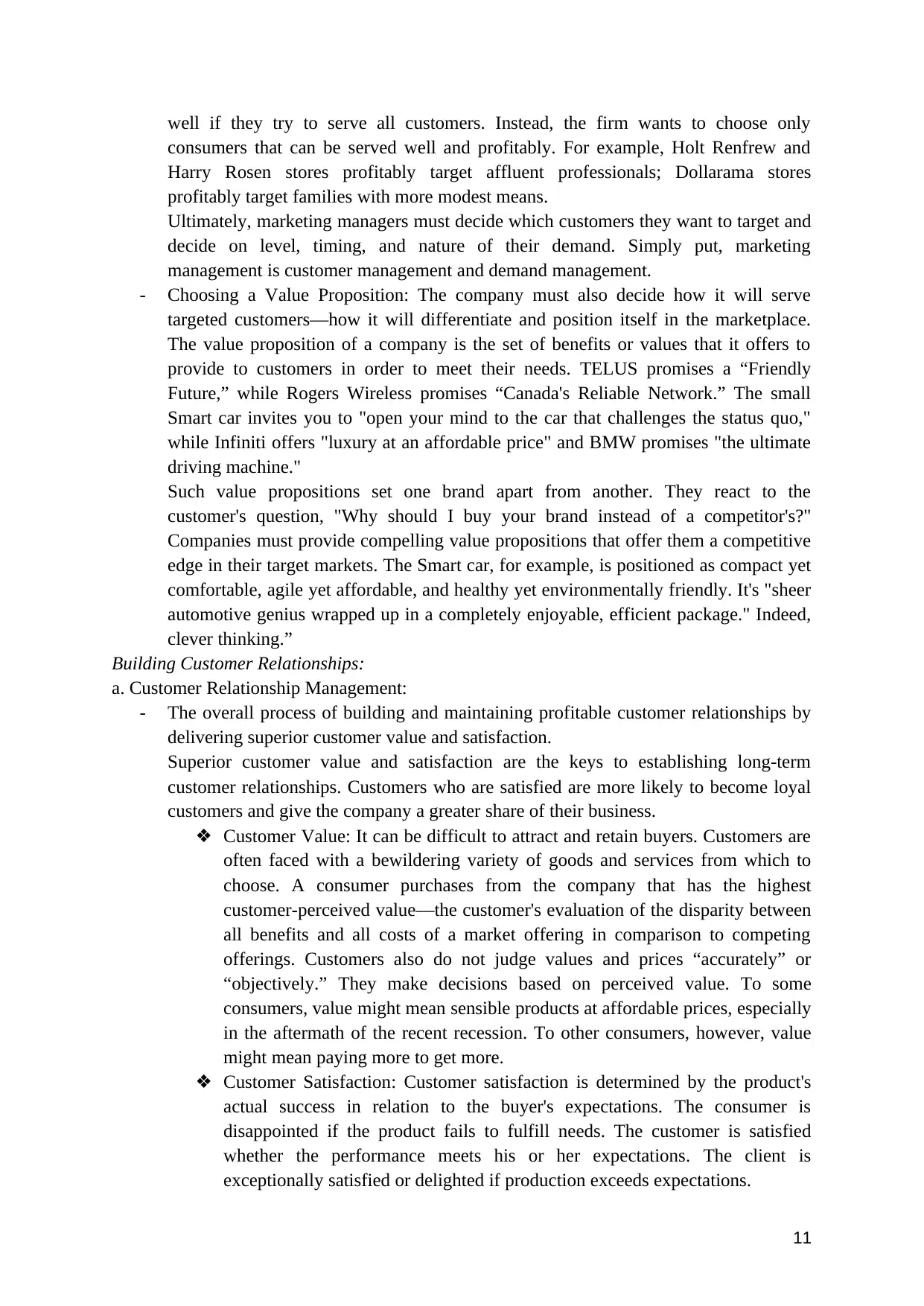
well if they try to serve all customers. Instead, the firm wants to choose only
consumers that can be served well and profitably. For example, Holt Renfrew and
Harry Rosen stores profitably target affluent professionals; Dollarama stores
profitably target families with more modest means.
Ultimately, marketing managers must decide which customers they want to target and
decide on level, timing, and nature of their demand. Simply put, marketing
management is customer management and demand management.
- Choosing a Value Proposition: The company must also decide how it will serve
targeted customers—how it will differentiate and position itself in the marketplace.
The value proposition of a company is the set of benefits or values that it offers to
provide to customers in order to meet their needs. TELUS promises a “Friendly
Future,” while Rogers Wireless promises “Canada's Reliable Network.” The small
Smart car invites you to "open your mind to the car that challenges the status quo,"
while Infiniti offers "luxury at an affordable price" and BMW promises "the ultimate
driving machine."
Such value propositions set one brand apart from another. They react to the
customer's question, "Why should I buy your brand instead of a competitor's?"
Companies must provide compelling value propositions that offer them a competitive
edge in their target markets. The Smart car, for example, is positioned as compact yet
comfortable, agile yet affordable, and healthy yet environmentally friendly. It's "sheer
automotive genius wrapped up in a completely enjoyable, efficient package." Indeed,
clever thinking.”
Building Customer Relationships:
a. Customer Relationship Management:
- The overall process of building and maintaining profitable customer relationships by
delivering superior customer value and satisfaction.
Superior customer value and satisfaction are the keys to establishing long-term
customer relationships. Customers who are satisfied are more likely to become loyal
customers and give the company a greater share of their business.
❖ Customer Value: It can be difficult to attract and retain buyers. Customers are
often faced with a bewildering variety of goods and services from which to
choose. A consumer purchases from the company that has the highest
customer-perceived value—the customer's evaluation of the disparity between
all benefits and all costs of a market offering in comparison to competing
offerings. Customers also do not judge values and prices “accurately” or
“objectively.” They make decisions based on perceived value. To some
consumers, value might mean sensible products at affordable prices, especially
in the aftermath of the recent recession. To other consumers, however, value
might mean paying more to get more.
❖ Customer Satisfaction: Customer satisfaction is determined by the product's
actual success in relation to the buyer's expectations. The consumer is
disappointed if the product fails to fulfill needs. The customer is satisfied
whether the performance meets his or her expectations. The client is
exceptionally satisfied or delighted if production exceeds expectations.
11
consumers that can be served well and profitably. For example, Holt Renfrew and
Harry Rosen stores profitably target affluent professionals; Dollarama stores
profitably target families with more modest means.
Ultimately, marketing managers must decide which customers they want to target and
decide on level, timing, and nature of their demand. Simply put, marketing
management is customer management and demand management.
- Choosing a Value Proposition: The company must also decide how it will serve
targeted customers—how it will differentiate and position itself in the marketplace.
The value proposition of a company is the set of benefits or values that it offers to
provide to customers in order to meet their needs. TELUS promises a “Friendly
Future,” while Rogers Wireless promises “Canada's Reliable Network.” The small
Smart car invites you to "open your mind to the car that challenges the status quo,"
while Infiniti offers "luxury at an affordable price" and BMW promises "the ultimate
driving machine."
Such value propositions set one brand apart from another. They react to the
customer's question, "Why should I buy your brand instead of a competitor's?"
Companies must provide compelling value propositions that offer them a competitive
edge in their target markets. The Smart car, for example, is positioned as compact yet
comfortable, agile yet affordable, and healthy yet environmentally friendly. It's "sheer
automotive genius wrapped up in a completely enjoyable, efficient package." Indeed,
clever thinking.”
Building Customer Relationships:
a. Customer Relationship Management:
- The overall process of building and maintaining profitable customer relationships by
delivering superior customer value and satisfaction.
Superior customer value and satisfaction are the keys to establishing long-term
customer relationships. Customers who are satisfied are more likely to become loyal
customers and give the company a greater share of their business.
❖ Customer Value: It can be difficult to attract and retain buyers. Customers are
often faced with a bewildering variety of goods and services from which to
choose. A consumer purchases from the company that has the highest
customer-perceived value—the customer's evaluation of the disparity between
all benefits and all costs of a market offering in comparison to competing
offerings. Customers also do not judge values and prices “accurately” or
“objectively.” They make decisions based on perceived value. To some
consumers, value might mean sensible products at affordable prices, especially
in the aftermath of the recent recession. To other consumers, however, value
might mean paying more to get more.
❖ Customer Satisfaction: Customer satisfaction is determined by the product's
actual success in relation to the buyer's expectations. The consumer is
disappointed if the product fails to fulfill needs. The customer is satisfied
whether the performance meets his or her expectations. The client is
exceptionally satisfied or delighted if production exceeds expectations.
11
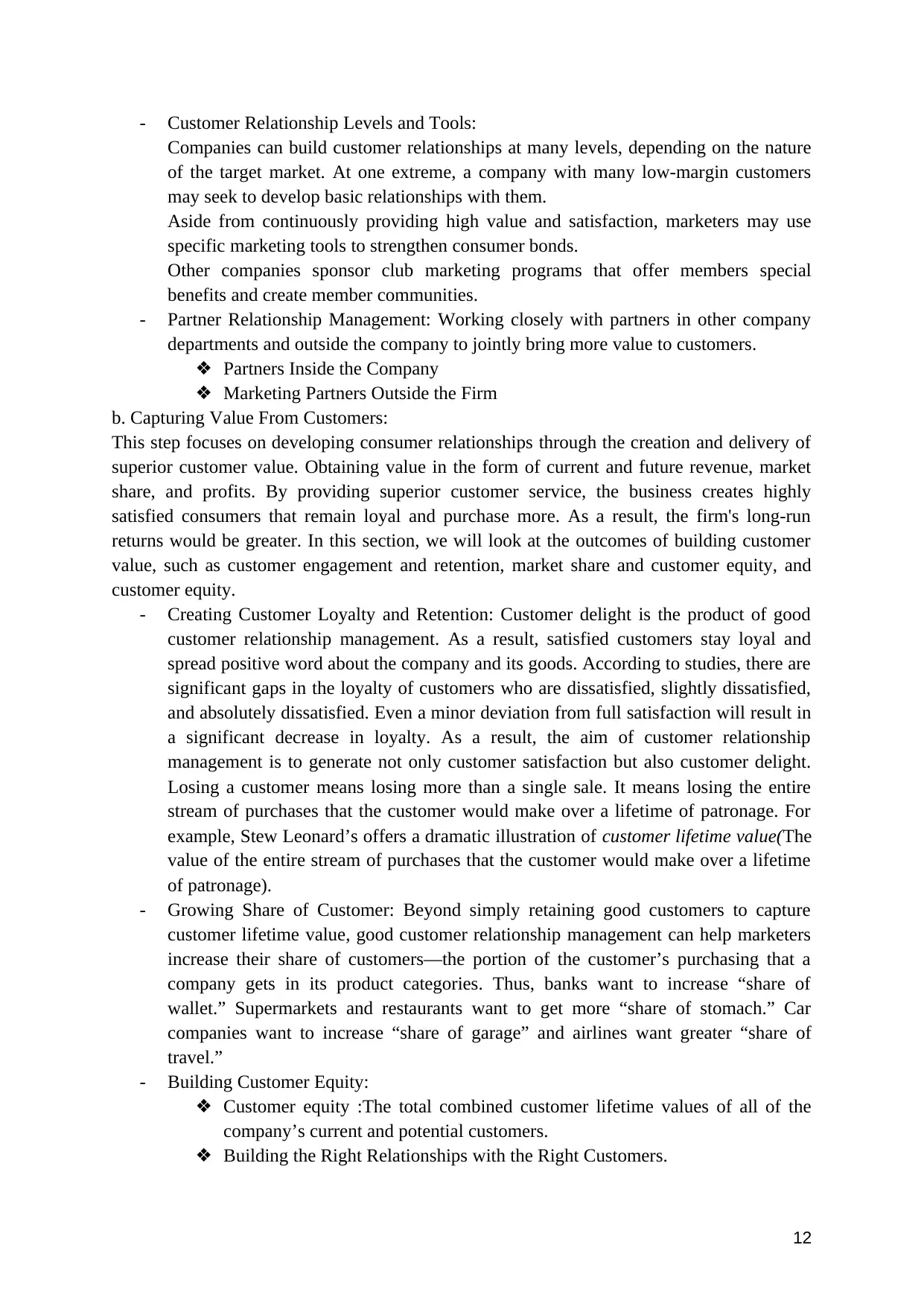
- Customer Relationship Levels and Tools:
Companies can build customer relationships at many levels, depending on the nature
of the target market. At one extreme, a company with many low-margin customers
may seek to develop basic relationships with them.
Aside from continuously providing high value and satisfaction, marketers may use
specific marketing tools to strengthen consumer bonds.
Other companies sponsor club marketing programs that offer members special
benefits and create member communities.
- Partner Relationship Management: Working closely with partners in other company
departments and outside the company to jointly bring more value to customers.
❖ Partners Inside the Company
❖ Marketing Partners Outside the Firm
b. Capturing Value From Customers:
This step focuses on developing consumer relationships through the creation and delivery of
superior customer value. Obtaining value in the form of current and future revenue, market
share, and profits. By providing superior customer service, the business creates highly
satisfied consumers that remain loyal and purchase more. As a result, the firm's long-run
returns would be greater. In this section, we will look at the outcomes of building customer
value, such as customer engagement and retention, market share and customer equity, and
customer equity.
- Creating Customer Loyalty and Retention: Customer delight is the product of good
customer relationship management. As a result, satisfied customers stay loyal and
spread positive word about the company and its goods. According to studies, there are
significant gaps in the loyalty of customers who are dissatisfied, slightly dissatisfied,
and absolutely dissatisfied. Even a minor deviation from full satisfaction will result in
a significant decrease in loyalty. As a result, the aim of customer relationship
management is to generate not only customer satisfaction but also customer delight.
Losing a customer means losing more than a single sale. It means losing the entire
stream of purchases that the customer would make over a lifetime of patronage. For
example, Stew Leonard’s offers a dramatic illustration of customer lifetime value(The
value of the entire stream of purchases that the customer would make over a lifetime
of patronage).
- Growing Share of Customer: Beyond simply retaining good customers to capture
customer lifetime value, good customer relationship management can help marketers
increase their share of customers—the portion of the customer’s purchasing that a
company gets in its product categories. Thus, banks want to increase “share of
wallet.” Supermarkets and restaurants want to get more “share of stomach.” Car
companies want to increase “share of garage” and airlines want greater “share of
travel.”
- Building Customer Equity:
❖ Customer equity :The total combined customer lifetime values of all of the
company’s current and potential customers.
❖ Building the Right Relationships with the Right Customers.
12
Companies can build customer relationships at many levels, depending on the nature
of the target market. At one extreme, a company with many low-margin customers
may seek to develop basic relationships with them.
Aside from continuously providing high value and satisfaction, marketers may use
specific marketing tools to strengthen consumer bonds.
Other companies sponsor club marketing programs that offer members special
benefits and create member communities.
- Partner Relationship Management: Working closely with partners in other company
departments and outside the company to jointly bring more value to customers.
❖ Partners Inside the Company
❖ Marketing Partners Outside the Firm
b. Capturing Value From Customers:
This step focuses on developing consumer relationships through the creation and delivery of
superior customer value. Obtaining value in the form of current and future revenue, market
share, and profits. By providing superior customer service, the business creates highly
satisfied consumers that remain loyal and purchase more. As a result, the firm's long-run
returns would be greater. In this section, we will look at the outcomes of building customer
value, such as customer engagement and retention, market share and customer equity, and
customer equity.
- Creating Customer Loyalty and Retention: Customer delight is the product of good
customer relationship management. As a result, satisfied customers stay loyal and
spread positive word about the company and its goods. According to studies, there are
significant gaps in the loyalty of customers who are dissatisfied, slightly dissatisfied,
and absolutely dissatisfied. Even a minor deviation from full satisfaction will result in
a significant decrease in loyalty. As a result, the aim of customer relationship
management is to generate not only customer satisfaction but also customer delight.
Losing a customer means losing more than a single sale. It means losing the entire
stream of purchases that the customer would make over a lifetime of patronage. For
example, Stew Leonard’s offers a dramatic illustration of customer lifetime value(The
value of the entire stream of purchases that the customer would make over a lifetime
of patronage).
- Growing Share of Customer: Beyond simply retaining good customers to capture
customer lifetime value, good customer relationship management can help marketers
increase their share of customers—the portion of the customer’s purchasing that a
company gets in its product categories. Thus, banks want to increase “share of
wallet.” Supermarkets and restaurants want to get more “share of stomach.” Car
companies want to increase “share of garage” and airlines want greater “share of
travel.”
- Building Customer Equity:
❖ Customer equity :The total combined customer lifetime values of all of the
company’s current and potential customers.
❖ Building the Right Relationships with the Right Customers.
12
⊘ This is a preview!⊘
Do you want full access?
Subscribe today to unlock all pages.

Trusted by 1+ million students worldwide
1 out of 17
Related Documents
Your All-in-One AI-Powered Toolkit for Academic Success.
+13062052269
info@desklib.com
Available 24*7 on WhatsApp / Email
![[object Object]](/_next/static/media/star-bottom.7253800d.svg)
Unlock your academic potential
Copyright © 2020–2025 A2Z Services. All Rights Reserved. Developed and managed by ZUCOL.





